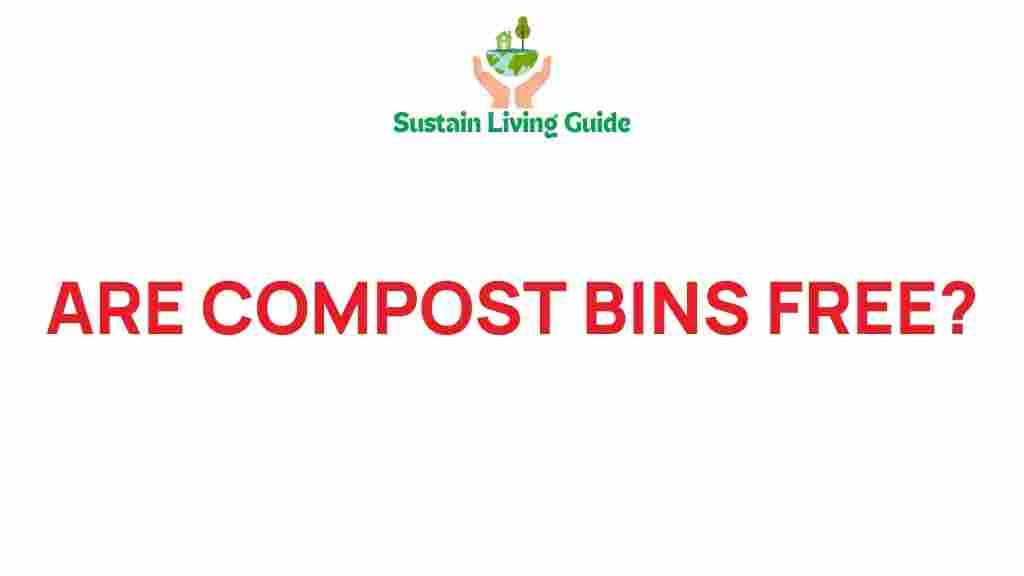Are Compost Bins Free? Discover the Hidden Costs of Going Green
As the world becomes increasingly aware of environmental issues, more people are looking to composting as a way to reduce waste and enrich their gardens. But while the idea of composting may seem straightforward and cost-effective, many wonder: are compost bins free? In this article, we’ll explore the different types of compost bins, their costs, and the hidden expenses associated with going green.
Understanding Compost Bins
Before we dive into the costs, let’s clarify what compost bins are. Compost bins are containers that facilitate the decomposition of organic waste, such as food scraps and yard waste, turning them into nutrient-rich compost. While some people choose to create DIY compost bins from pallets or other materials, others opt for pre-manufactured models.
Types of Compost Bins
There are several types of compost bins available, each varying in price and functionality:
- DIY Compost Bins: These can be made from wood pallets, wire mesh, or even repurposed containers. The cost can be as low as zero if you have the materials on hand.
- Plastic Compost Bins: These are commercially available and typically range from $50 to $200. They are lightweight and often come with features like ventilation and tumbling mechanisms.
- Wooden Compost Bins: These bins are aesthetically pleasing but can be more expensive, ranging from $100 to $300, depending on the design and quality of materials used.
- Worm Compost Bins: Also known as vermicomposting systems, these bins are specifically designed for composting with worms. Prices range from $50 to $150.
The Cost Breakdown of Compost Bins
So, are compost bins free? The answer is complicated. While it is possible to create a compost bin with little to no cost, there are several factors to consider that may affect your budget.
Initial Investment
The initial investment for a compost bin can vary widely:
- DIY Compost Bin: If you have the materials at home, you might spend nothing. However, if you need to purchase materials, the cost can be around $20 to $50.
- Store-Bought Compost Bins: Expect to spend anywhere from $50 to $300, depending on the type and features of the bin you choose.
Maintenance Costs
After your initial investment, there are ongoing maintenance costs to consider:
- Tools and Accessories: You may need a pitchfork, shovel, or compost thermometer. These can add an extra $20 to $100 to your overall expenses.
- Organic Materials: While many of the materials you compost are free, you might need to purchase additional brown materials (like leaves or shredded paper) if your yard waste is insufficient.
- Worms (for Vermicomposting): If you choose to use a worm bin, purchasing the worms can cost around $25 to $50.
Hidden Costs of Composting
While the direct costs of compost bins are often the primary concern, there are several hidden costs associated with composting:
Time Investment
Composting requires time and effort. Factors to consider include:
- Monitoring: Regularly checking moisture levels and turning the compost can take time. This might add up to a few hours a month.
- Learning Curve: If you’re new to composting, there may be a learning period where you need to research best practices.
Space Requirements
Composting requires space, and if you live in an apartment or have limited outdoor space, you might need to invest in a smaller, indoor composting solution, which can be costly.
Potential Local Regulations
Some municipalities have regulations regarding composting. You may need to check local laws to ensure you comply, which could involve additional costs if fines are incurred or if you need to buy a specific type of bin.
Step-by-Step Guide to Composting
If you’re ready to start composting, follow this simple guide:
Step 1: Choose Your Compost Bin
Decide whether you want to go for a DIY option or purchase a commercially available compost bin. Consider your budget, space, and preferences.
Step 2: Gather Materials
Collect organic waste such as:
- Fruit and vegetable scraps
- Yard waste (leaves, grass clippings)
- Coffee grounds and filters
- Eggshells
Step 3: Layer Your Compost
Start with a layer of brown materials (dry leaves, cardboard) followed by green materials (food scraps, grass clippings). Alternate layers for optimal decomposition.
Step 4: Maintain Your Compost
Turn your compost every few weeks to aerate it, and keep it moist but not soggy. Monitor the temperature and adjust materials as necessary.
Step 5: Harvest Your Compost
After several months, your compost should be dark and crumbly. Use it to enrich your garden soil or potted plants!
Troubleshooting Common Composting Issues
Even seasoned composters may encounter challenges. Here are some common issues and solutions:
Odor Issues
If your compost smells bad, it may be too wet or contain too many green materials. To fix this:
- Add more brown materials to balance the mix.
- Turn the compost to aerate it.
Pests
Fruit flies and other pests can be attracted to compost bins. To deter them:
- Cover food scraps with brown materials.
- Use a well-sealed compost bin.
Slow Decomposition
If your compost isn’t breaking down, check the balance of materials. You may need to:
- Add water if it’s too dry.
- Turn the pile to introduce more air.
Conclusion
In summary, while you can start composting with little to no cost by using DIY compost bins, there are hidden costs to consider, from maintenance to time investment. Ultimately, the decision to compost—and how much you invest in it—depends on your personal goals for sustainability, gardening, and waste reduction. If you’re interested in learning more about composting or finding resources, check out our comprehensive composting guide. Remember, every little effort counts in making the planet greener!
For more information on composting techniques, visit the EPA’s composting page.
This article is in the category Waste and created by SustainLivingGuide Team
